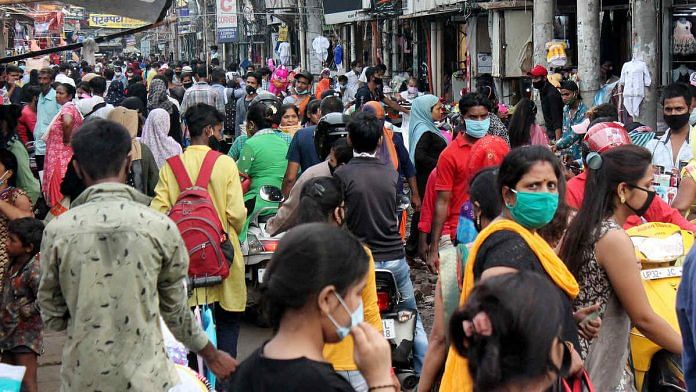New Delhi: India’s population could increase by 10 per cent in the next 16 years from the current mark of about 138 crore, a technical group on population projections constituted by the Ministry of Health in 2014 has predicted.
The report submitted by group states: “The population of India is expected to increase from 121.1 crore to 152.2 crore during the period 2011-2036 — an increase of 25.7 per cent in 25 years at the rate of 1.0 per cent annually. As a consequence, the density of the population will increase from 368 to 463 persons per square kilometre.”
The group consists of senior officials of the health ministry and the NITI Aayog, along with several independent academics including Amitabh Kundu, distinguished fellow at JNU, P.M. Kulkarni, former professor at the same university, F. Ram, former director of Mumbai’s International Institute of Population Sciences (IIPS), and Chander Shekhar of the same institute.
The last official government data on population, from the 2011 Census, had pegged it at 121.1 crore, but various United Nations agencies estimate that the figure has gone up to Rs 138 crore. A recent study in The Lancet journal had predicted that India’s population would peak in 2048 at 160 crore.
Also read: Why India’s population growth will be much slower than predicted — 1.6 billion by 2048
Methodology
The government-constituted group used the Cohort Component Method of making population projections, using fertility, mortality and migration rates.
The states and union territories analysed using this method were Andhra Pradesh, Assam, Bihar, Gujarat, Haryana, Himachal Pradesh, Karnataka, Kerala, Madhya Pradesh, Maharashtra, Odisha, Punjab, Rajasthan, Tamil Nadu, Telangana, Uttar Pradesh, West Bengal, Jharkhand, Chhattisgarh, Uttarakhand, Jammu & Kashmir (UT) and the National Capital Territory of Delhi.
In his foreword to the report, Registrar General and Census Commissioner Vivek Joshi wrote: “I hope the data and information given in this report will be of immense use to the government ministries, departments, policy makers and planners, research institutes, and other users to have better understanding of the changes that are taking place in the country and in designing and programmes in the fields of population, health, nutrition and many more.”
Demographic dividend set to rise
The report also projects a change in the age structure of the population, with an increase in people of working age. However, there will also be a proportionate increase in the number of old people and a consequent increase in the death rate.
“Between 2011 and 2036, because of the declining fertility, the proportion of population aged under 15 years is projected to decline from 30.9 to 20 per cent. The proportion of the middle age-group (15-59 years) and the older ages (60 years and above) are set to increase considerably,” the report states.
“With declining fertility, along with the increases in life expectancy, the number of older persons in the population is expected to increase by more than double from 10 crore in 2011 to 23 crore in 2036 — an increase in their share to the total population from 8.4 to 14.9 per cent,” it explains.
“The proportion of population in the working age-group of 15-59 years is expected to rise from 60.7 percent in 2011 to 64.9 percent in 2036,” the report adds.
The population of children in the 5-14 years age group is expected to decline from 25.4 crore in 2011 to 20.9 crore in 2036. The youth population in the age group 15-24 years is expected to increase from 23.3 crore in 2011 to 25.1 crore in 2021, and then continue to decrease to 22.9 crore in 2036. These changes in the age composition will mean that while 50.2 per cent of the population in the country was aged 24 years and below in 2011, that figure will go down to 35.3 per cent in 2036, of which 20.2 per cent will be in the ages 0-14 and 15.1 percent in the ages 15-24.
State-wise increases
Delhi-NCR will have the highest projected growth of 98 per cent in the 2011-2036 period, and Himachal Pradesh the least at 6 per cent. Regions with projected growth in the range of 10-20 per cent are Andhra Pradesh, Punjab, Jammu & Kashmir, Manipur, Karnataka, Odisha, Maharashtra, Telangana and West Bengal.
The population in Gujarat, Rajasthan, Madhya Pradesh, Nagaland, Uttar Pradesh, Mizoram, Puducherry, Bihar, Meghalaya, Arunachal Pradesh, Dadra & Nagar Haveli and Daman & Diu is projected to increase by more than 30 per cent.
The report states: “Of the projected increase in population of 31.1 crore in India during 2011-36, 17 crore are likely to occur in the five states of Bihar, Uttar Pradesh Maharashtra, West Bengal and Madhya Pradesh. Thus, nearly 50 per cent of India’s demographic growth during this period of 25 years is projected to take place in these five states.
“Nineteen per cent of the total population increase in India of 31.1 crore during 2011-36 is anticipated to occur in Uttar Pradesh alone. The population in these five states together is expected to grow at 1.0 per cent per annum during 2011-36.”
Also read: Slowing population growth means time is running out for India to get rich




It is not good news China has 800m working population and India only have 442m and our population is just less then 30million if we want to develop India need to make women empowerment
Because u can’t compete with China until women take command with men
Population 156cr by 2036??
Bill gates n other stooges of illumanti have some other plan under New World Order.